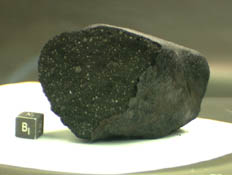
March 17 2000
Yukon Meteorite Bonanza
Left:
This piece of the Yukon meteorite weighs in at 156.8 grams. The reference cube measures 1 centimeter across. The stone fell after a fireball exploded over the Yukon Territory
in January. This and other samples of the meteorite are being analyzed
at NASA's Johnson Space Center. Courtesy NASA/JSC. Click on image for
larger view.
When a large chunk of interplanetary debris exploded in the early morning sky over western Canada on January 18th 2000, it did more than rattle the residents below and leave a lingering, smoky trail high in the atmosphere. The event also dropped a cluster of dark meteorites on the region's frozen, snow-covered surface. Fortunately, an alert resident found several of the black stones in the days thereafter and whisked them — still frozen — into the hands of geologists at the University of Calgary. Although the discoverer remains anonymous, he has allowed the Canadian government to let NASA scientists conduct the first analyses.
Since then the fragments, which total about a kilogram (2 pounds), have rocketed to superstardom in the eyes of meteorite scientists worldwide. Thatís because the Yukon meteorite is a carbonaceous chondrite — rare, unaltered matter from the earliest time in solar-system history. Only about 2 percent of all known meteorites are of this type, because the crumbly rock is easily destroyed during atmospheric entry or by erosion once on the ground. Scientists are especially ecstatic over the stonesí quick recovery and handling by the discoverer. "Itís a textbook case of how this should be done," observes Richard Herd, the curator of natural collections for the Geological Survey of Canada.
The Yukon meteorite made its public debut yesterday at the annual Lunar and Planetary Science Conference in Houston, Texas. According to Michael Zolensky (NASA/Johnson Space Center), the new find should contain a remarkable assortment of compounds present when the stone formed 4.5 billion years ago: flecks of interstellar dust, water, and perhaps dozens of complex organic compounds — all virtually certain to be free of terrestrial contamination. Itís been more than three decades since carbonaceous chondrites like this one were discovered after falling to Earth. Those finds, Murchison in Australia and Allende in Mexico, revolutionized knowledge about the primordial solar system, and meteorite researchers are understandably eager to study the new arrival. "This is probably the only time in my career this will happen," notes Zolensky.
For details and additional
photographs, see the online press
release.